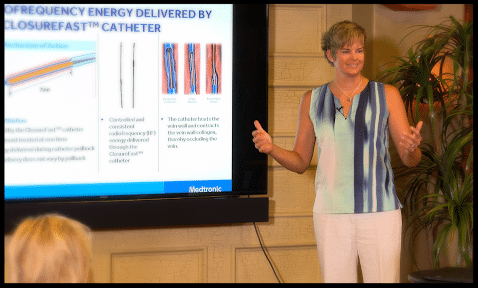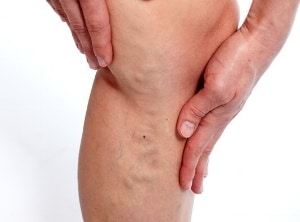
Leg Vein Surgery vs. In-Office Leg Vein Procedures
Varicose vein surgery not what it used to be
If you have heard—or experienced--stories about standard vein removal surgery that happened prior to the turn of this century, it is understandable if you are concerned about seeking help from a qualified vein specialist for your painful varicose veins. There was a time when leg vein surgery only referred to vein procedures such as vein stripping, ambulatory phlebectomy, and vein ligation, painful procedures, likely involving general anesthetic, and definitely involving long and difficult recovery times.
The good news is that there is no longer a need for concern. Today, there is a range of minimally invasive, maximally effective procedures that can have you back on your feet with a much improved quality of life in very little time. Many of these procedures can be performed in a clinic, on an out-patient basis, with local anesthetic.
If you are experiencing the discomfort of varicose veins, it is a great time to get assessed by a qualified vein specialist to ensure that you are not also experiencing the effects of Chronic Venous Insufficiency.
There are treatments for varicose veins besides invasive leg vein surgery
At Advanced Vein Institute of Arizona, we do not perform ligation or vein stripping. We consider those to be archaic and outmoded treatments. A qualified vein specialist at a modern vein clinic can assess your vascular health, and tailor a treatment plan to your specific needs, without the pain and discomfort of yester-year. Treatment options could include:
• Medical Adhesive: VenaSeal™ Closure System.: VenaSeal™ Closure System. The revolutionary, FDA approved VenaSeal™ procedure uses a medical grade adhesive to close off diseased superficial veins. Blood is re-routed to other healthy veins in the leg, and the hardened veins are gradually reabsorbed by the body.
• Laser Treatment: Endovenous Laser Treatment (EVLT). Endovenous Laser Treatment (EVLT). Endovenous Laser Ablation or Endovenous Laser Treatment (EVLA/EVLT) utilizes laser heat to ablate, or destroy, an incompetent saphenous vein. It usually takes about an hour, is minimally invasive, and can be performed in-office.
• Radiofrequency Ablation: ClosureFast Radiofrequency Procedure. ClosureFast Radiofrequency Procedure. Similar in approach to Endovenous Laser Ablation, radiofrequency ablation relies instead on radio frequency energy (electricity) to heat and collapse dysfunctional veins.
• Sclerotherapy. Sclerotherapy is a very commonly used to treat small varicose and spider veins. Using a very small needle, a chemical foam or liquid, called a sclerosant, is injected into the offending vein where it acts as an irritant, causing the vein walls to collapse and be dissolved by the body.
You don’t have to suffer from the symptoms of varicose veins. Book your consultation and full exam with a qualified vein specialist today.
Is there anything worse than itchy varicose veins? Maybe, but itchy veins remains high on the list of issues we would love to resolve before they drive us crazy. If you are experiencing itching around your varicose veins, it could be a message from your body that it is time to have your veins checked…
Read MoreThe full story on Chronic Venous Insufficiency, what it is and how to treat it. A video presentation by Jilanne Rose, DNP-C, Clinical Director. Run Time 24:46. TRANSCRIPT What’s the Difference Between Veins and Arteries? When we talk about vascular health and vascular disease most people think about arteries. When we talk about the…
Read MoreA group of Gilbert Arizona Residents concerned about Chronic Venous Insufficiency gathered on Saturday July 16th for an interactive discussion on CVI symptoms, causes and treatments. Chronic Venous Insufficiency, Venous Reflux Disease and Varicose Veins affect over 30 million American men and women. Unfortunately, many do not get treated as they believe varicose veins are…
Read MoreCan Chronic Venous Insufficiency (CVI) be reversed? Unfortunately the short answer to this question is no; but CVI can be treated with minimally invasive procedures which can reduce symptoms and improve quality of life tremendously! Chronic Vein Insufficiency Causes In order to understand why venous insufficiency or peripheral venous insufficiency cannot be reversed, we must…
Read MoreWhat can you do to treat bleeding varicose vein and spider veins? First and foremost, don’t panic. Although the visual effect of a ruptured varicose vein or bleeding vein can be alarming, there are some simple things that can be done to get the bleeding to stop. If you can reach the area that is…
Read MoreWhy are varicose veins painful? The discomfort associated with varicose veins is caused by a combination of factors. When veins are weak, the blood which is supposed to return to the heart in a timely fashion, settles and pools in the superficial vein system. This pooling of blood worsens when patients stand or sit in…
Read MoreEndovenous Ablation Definition Taken literally, endovenous ablation is the removal of a vein from within. ‘Endo’ means internal or inside, ‘venous’ refers to a vein, and ablation is to ‘remove’. In the instance of veins, it is no longer necessary to physically remove a vein from the leg (vein stripping) to improve symptoms or the…
Read MoreThe newest procedure for the treatment of varicose veins was approved by the FDA about two years ago. It is what has been termed a non-tumescent non-thermal therapy. What this means is that it does not require a lot of numbing medicine to complete, and it does not use a heating element to close or…
Read MoreWhat is the best treatment for varicose veins? No varicose vein is the same; no person’s symptoms are the same; and so the best procedure for varicose veins is not always the same. The treatments associated with vein disease are based on a patient’s symptoms, vein size, location, contributing conditions, and ultrasound findings. Different…
Read More

